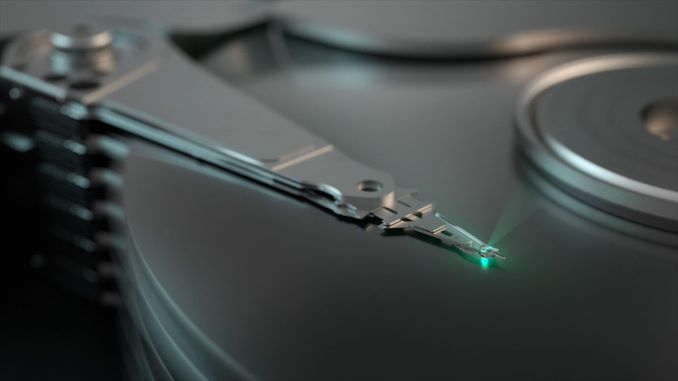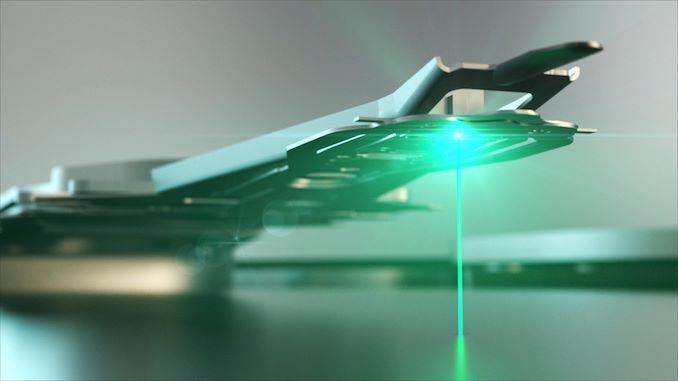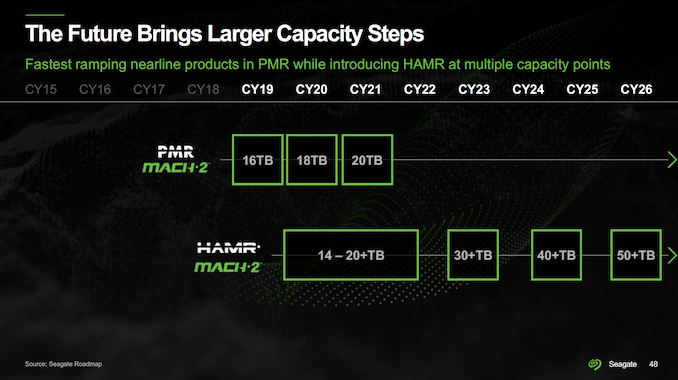Seagate Confirms 30TB+ HAMR HDDs in Q3, Envisions 50TB Drives in a Few Years
by Anton Shilov on January 27, 2023 6:00 PM EST
Seagate this week confirmed plans to launch the industry's first 30+ TB hard drive that uses its heat assisted magnetic recording (HAMR) technology, as well as reaffirming its commitment to release HDDs with capacities of 50 TB and higher in a few years. But before this happens, the company will release 22 TB and 24 TB HDDs that will rely on perpendicular magnetic recording (PMR) and shingled magnetic recording (SMR) technologies, respectively.
One More Play for PMR and SMR
Various energy assisted magnetic recording methods, such as HAMR, will be used for next generations of hard drives for years to come. But while PMR is running out of steam, it is still evolving. Seagate has managed to increase areal density enabled by its PMR + TDMR platform by around 10%, enabling 2.2 TB 3.5-inch HDD platters and thus 22 TB hard drives featuring 10 of such disks. Furthermore, by using shingled recording, these drives can have their capacity stretched to 24 TB.
These 22 TB and 24 TB Seagate Exos drives will likely be drop-in compatible with existing cloud datacenter hardware as well as infrastructure, and should not require extensive validation and certification procedures, unlike brand-new HAMR HDDs. As a result, Seagate's customers will be able to deploy such hard drives fairly quickly and increase storage density and storage capacity of their datacenters.
Seagate is now ramping up production of its 22 TB hard drives for datacenters, so expect the company to start their shipments shortly. Seagate is not disclosing when exactly it will officially launch its 22 TB and 24 TB parts, but we would expect them to arrive before the company introduces its HAMR-based HDDs; so think Q1 or Q2.
30+ TB HDDs Coming in Q3
In fact, Seagate has been shipping HAMR HDDs to select customers for evaluation as well as inside its own Lyve storage systems for a while, but those drives featured capacities akin to those of PMR/CMR HDDs and were not available in huge volumes. With Seagate's 2nd generation HAMR platform, the company is going after higher volumes, but it took the company quite some time to get there. The first pre-qualification high-capacity HAMR-based HDDs are only just now getting ready to head out to customers for evaluation.
"We are meeting or exceeding all product development milestones and reliability metrics, and we will be shipping pre-qualification units to key cloud customers in the coming weeks," said Dave Mosley, chief executive of Seagate.
Meanwhile, commercial HAMR hard drives with capacities of 30TB or higher will ship in third quarter of this year, which is in-line with what Seagate promised last year.
"As a result of this progress, we now expect to launch our 30-plus terabyte platform in the June quarter, slightly ahead of schedule," said Mosley. "The speed of the initial HAMR volume ramp will depend on a number of factors, including product yields and customer qualification timelines."
Initially Seagate will only offer its HAMR technology for its highest-capacity offerings for hyperscale datacenters, whom need maximum storage density and are willing to pay premium for the drives and for supporting infrastructure. As yields of HAMR-supporting media and the appropriate read/write heads increase, the technology will be applied for drives with lower capacities in a bid to cut down their production costs (fewer disks and heads, lower the costs). This is not going to happen overnight though, as the company needs to increase yields of HAMR drive components and the HDDs themselves to a comfortable level.
"I think this year, [the volume of HAMR HDDs] will probably still be relatively low," said the head of Seagate. "Then the faster we can get the yields and scrap and all the costs that we can control down on the heads and media, then the faster we'll be accelerating. I think that will happen in calendar year 2024 and calendar year 2025 will just continue to accelerate. The highest capacity points will be addressed, but also these midrange capacity points."
50+ TB HDDs Will Be Here in a Few Years
Seagate's launch of its first mass market 30+ TB HAMR hard drives platform will mark a milestone for the company and the whole industry. But apparently the company has another breakthrough to share at this time. The firm said this week that it had created 5 TB platters for 3.5-inch hard drives, which presumably entails new media, new write heads, and new read heads.
"It was nearly four years ago to the day that I first shared our lab results demonstrating 3 TB per disk capacities," explained Mosley. "And today, we have demonstrated capacities of 5 TB per disk in our recording physics labs."
For now, these platters are used on spinstands for evaluation and testing purposes, but platters like these will allow for 50 TB HDDs a few years down the line. Seagate's roadmap indicates that such hard drives will hit the market sometimes in calendar 2026.
It is unclear how thin the new platters are. But following current trends of nearline HDD evolution — increasing areal density and increasing number of platters per hard drive — it's not outside the realm of possibility that Seagate will find ways to integrate even more than 10 platters in future drives. In which case Seagate would be able to hit drive sizes even larger than 50 TB.
In any case, with ~3 TB platters in production, samples of ~30 TB HDDs shipping to customers, and 5 TB platters demonstrated in the lab, Seagate's HAMR roadmap seems to look quite solid. Therefore, expect hard drives to gain capacities rapidly in the coming years.












70 Comments
View All Comments
The Von Matrices - Tuesday, January 31, 2023 - link
SAS for multi actuator drives is really just a hack. SAS was originally designed to have two links per drive for redundancy, and then the dual-actuator drives repurposed that dual-link design to have a single link for each actuator with no redundancy. There's no technical reason why there can't be two SATA or PCIe links per drive other than the lack of a standard connector.TheinsanegamerN - Tuesday, January 31, 2023 - link
These are for servers, so 99.9999999% of the time your LAN connection will be the limitation. Even with multiple 10Gbps in aggregate you'll saturate the network long before you saturate the hard drives.meacupla - Saturday, January 28, 2023 - link
I am somewhat interested in seeing what HAMR can do for the 2.5in segment. The maximum for 2.5in HDDs is 5TB, and it's in that taller 15mm height configuration. An SSD offers 8TB in the normal 2.5in 7mm height drive, but the cost of that is astronomical in comparison.nandnandnand - Saturday, January 28, 2023 - link
https://blocksandfiles.com/2023/01/10/fourth-2022-...https://www.techspot.com/news/97294-shipments-hdds...
I'm surprised to see so many 2.5" HDDs being shipped. It should be some mix of cheap laptops and portable drives.
cbm80 - Saturday, January 28, 2023 - link
also game consoles and DVRscbm80 - Saturday, January 28, 2023 - link
Will probably never happen. The HD makers haven't done anything with 2.5" since they hit the 1.0TB/platter level in 2016.abufrejoval - Sunday, January 29, 2023 - link
The last thing they did was the main killer in my mind: switching to shingled recording on near all 2.5" units.Without that I might have kept them around a little longer, because I still run RAID6 and don't need that much capacity.
But at these sizes anything beyond a mirror set is just way too much capacity, even if I preferred the bandwidth of RAIDs for shorter backups on my 10Gbit network.
Railgun - Sunday, January 29, 2023 - link
"We are meeting or exceeding all product…reliability metrics” said no one outside of Seagate ever.UltraTech79 - Monday, January 30, 2023 - link
God these people are such LIARS.We might see 30 TB in a few years. We will *NEVER SEE* 50TB.
50TB would be in roughly 6 years. You know what else will be going on in 6 years? 32 and 64 TB SSDs.
Oh but those will be so costly! I can hear you say. Yes. They will be the newest highest capacity drives. Of course they will cost a lot. However, and this is important, they will not cost more than a 50TB HDD.
The industry KNOWS this is coming. Yet they keep trying to bullshit up with "50 TB is coming soon!" as if we are too stupid to realize the writing on the wall; HDD tech has about 5 years left in it before no one outside of rediculopusly good deals invests into it. So they continue to try and semi con us with social engineering so people expect this to come. And in three years when it doesnt and they are still promising it at 32TB, people will still believe it, and SSDs will be at 16TB for the price of what 4TB SSD is right now.
The only reason HDD is still around is upfront cost. Becuse it is worse at literally everything else, and that changes in less than 6 years.
Marko123 - Monday, January 30, 2023 - link
You are grossly over estimating the future cost scaling of NAND Flash. If you look up some historical data (WD are unbiased so are a good source) you'll see the $/GB gap has not really closed. SSDs got a bump improvement moving to 3D. HDDs will get a bump improvement moving to HAMR.